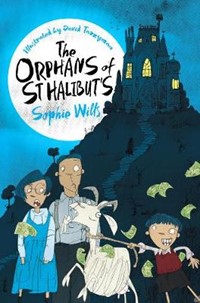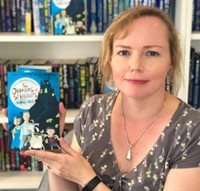Sophie Wills


About Author
Sophie grew up in Chelmsford, Essex. She failed the 11+, had a weekend job at a boarding kennels where she suffered workplace bullying from a goat, and nurtured a dream to have a career she could do in her pyjamas. She worked at two London publishers before finally achieving her ambition by going freelance in 2003.
She entered Mumsnet's first Bedtime Story competition in 2012 and Michael Rosen picked out as a winner her story about a pig-riding sheriff.
Sophie lives on the edge of south-east London with her family and her debut middle-grade, The Ophans of St Halibut's, illustrated by David Tazzyman, was acquired at auction by Macmillan and will be published on 1 October 2020.
Interview
THE ORPHANS OF ST HALIBUTS
MACMILLAN CHILDREN'S BOOKS
OCTOBER 2020
THE ORPHANS OF ST HALIBUTS is a fast-paced, hilarious debut about a group of orphans involving accidental deaths, some dark secrets and a bad-tempered goat, brilliantly illustrated by David Tazzyman.
We asked author SOPHIE WILLS to tell us more about THE ORPHANS OF ST HALIBUTS:
Q: What brought you into writing for children? What other kinds of jobs have you done?
A: I wanted to be an author almost from the moment I could read, but I got distracted briefly when I went to university - OK, for about 20 years. In 2012 I noticed a short story competition, and decided that if I didn't at least try, I'd never forgive myself. Michael Rosen picked my story as one of the winners - that was enough to get me writing again.
As for jobs, I've been a kennel assistant, worked in a hardware store, and at a doctor's surgery; I've handled a lot of urine sample bottles. I then worked in publishing for six years - adult fiction - and since 2003 I've been a freelance copy-editor.
Q: Can you tell us what your debut, The Orphans of St Halibuts, is about - in a sentence?
A: Three orphans and a goat left home alone must pass an inspection by DEATH (the Department of Education, Assimilation, Training and Health) to avoid being sent to the sinister Mending House, but events get spectacularly out of hand. It's about friendship, being the underdog, and stolen cake. Oh, that's two sentences. Now it's thr--just stop, Sophie.
Q: It's a very funny, and action-packed, story - was it hard to write?
A: There are two answers to this: one is that it was a joy, and I had an absolute ball being very silly and throwing all sorts of mayhem in. I just wrote exactly what I wanted, and what I knew my children would enjoy. I wasn't trying to write like anyone else, or to a trend, so it's very me - that made it easy.
The other answer is that I had to rewrite it about a million times, got completely stuck and tangled up, and at various points wanted to throw it in the bin. Both are true. Make what you will out of that!
Q: What gave you the idea of the 'Mending House' where bad children go to be 'fixed'?
A: I visited a Victorian workhouse museum with my family as research, and we noticed that the workhouse children had to do a lot of rote learning of grammar and spelling - also a common complaint in our house at the time. One of my children commented that a head full of grammar terms probably stopped the children thinking of anything more interesting - so the Mending House was born.
The Mending Houses and orphanages in the book are inspected by DEATH, which is a remote, faceless bureaucracy more interested in whether boxes have been ticked than any actual education. DEATH is of course totally made up.
Q: Tig, Steph and Herc are the three remaining orphans at St Halibuts. How did they develop?
A: I started with Tig, and thought about what she wanted - to keep her friends together and avoid attention from everyone else. Then I gave her a brother and a friend who basically wanted the same things as her, but had totally different views about how to achieve them. So they spend a lot of time getting in each other's way accidentally. As soon as you have some conflict like this, it produces a lot of plot all by itself. I just wound them up and set them going towards each other and the clueless and/or wicked adults in their lives.
Q: And not forgetting Pamela, the goat. Is Pamela based on any goats you know?
A: Not just any goat. The Goat of Goats. The Uber-Goat. When I was 14 and working at a boarding kennels, Pamela was my nemesis. One of my jobs was to feed her and muck out her stall, and let's just say she was not entirely on board with that agenda. Apparently some goats like to test people, to see if they're a pushover. And I was, literally. Eventually we agreed a mutually respectful truce, in that she agreed not to headbutt me, tear my T-shirt with her teeth, or body-slam me as long as I kept out of her stall. I got really good at throwing her hay into her feeding rack from outside.
Q: There are a few baddies involved - who did you most enjoy creating?
A: Myers is the biggest baddie in this book, and I really enjoyed creating someone who likes to spread fear while getting his own hands dirty as little as possible. He uses people as puppets, and thinks he has the whole town under his control, but he hasn't counted on the orphans.
I have a very soft spot for the pharmacist, Bickley Brimstone. While Myers is an out-and-out villain, Brimstone is more of a vain, jealous charlatan. He is pretty annoyed that Myers gets all the attention in this book, and has carved himself out a bigger role in the sequel.
Q: The body count is quite high in this story - do you enjoy thinking up ways to bump off the bad guys?
A: I'm not sure I should be having this conversation without my lawyer present. All I'll say is that quite a bit of my daydreaming is spent on this subject. Villains need appropriate comeuppance, and it is my job to provide that. It's a public service, not a crime.
Q: What about David Tazzyman's illustrations, did he draw your world and characters as you'd imagined them?
A: I'm not a very visual writer at all. I can't 'see' people or places very clearly as some writers do, like a photo in my head - I just know them. It's hard to explain, but I know what a place feels like very vividly, far more than what it actually looks like. I did draw diagrams of the layout of St Halibut's and Sad Sack to make sure I described them consistently, but they were just for double-checking. And I don't describe characters' physical characteristics much - just a few basics, unless they have a bearing on the story. I think people's minds fill in details for them uniquely when they read. In fact, that's why reading is so special - each reader takes part in creating and tailoring the author's fictional world just for them. No one else sees it the same way they do.
When I saw David's art, it was as though he had shown me people that I knew really well already but who had been invisible till then. I was all 'So that's what you look like! Of course!' He captures personality brilliantly in his drawings and seems to instinctively understand what I'm getting at. I think we complement each other perfectly.
Q: What next for the orphans of St Halibut's?
A: They don't get to relax for long. It's time for Sad Sack to be connected to the rest of the world - or at least, to Little Wazzock, a few miles down the road. And there may not be room for pesky orphans in this brave new world, especially not questioning, independent ones. There will be sweet treats, bad knitting, posh hotels, extraordinary DIY, and badly behaved, deceitful, daft, and brazenly incompetent adults. Also, Pamela. And a goat stew. What, you think I wouldn't?
Q: Where and when do you do most of your writing?
A: I try to do most of it at my desk, but my brain often wakes me up at about two a.m. to excitedly tell me details about plots and characters, which I have to immediately transcribe bleary-eyed into the notes app on my phone. If I don't write them down then, in the morning my brain has a strop and refuses to tell me what they were. Autocorrect sometimes makes the notes even more interesting than they should be.
Q: Describe your ideal writer's shed (writer's snacks included!).
A: Very kind of you to offer. What's your budget? I'd like one with a mountain and lake view, decent heating (my hands get cold), and most importantly, a really good sound system to blast out my weirdly random Spotify playlist - the kids keep adding tracks from the Lego movie soundtrack. I find that when I'm listening to music, it affects the mood of what I'm writing. Sometimes I have to turn it off because it's distracting, but sometimes it does surprising and funny things to the scenes. I'll probably put on 'U Can't Touch This' by MC Hammer to get me started in the morning.
Snacks? I'm pretty easy. Twenty-three packets of Lindt 70% dark chocolate should get me through a day or so. Oh, and custard straight out of a carton. Also, cockle and crisp sandwiches with mayo. Fruit? Definitely - put some in a bowl on my desk, in case anyone comes in to judge my snacks.
Q: What's your favourite escape from your desk?
A: I love walking through the woods near my house, all alone. I listen to the parakeets screeching above me, and smile at other people's dogs in the hope they will come over so I can pet them. Sometimes I drag my husband out with me - he writes adult non-fiction - and we talk through each other's writing problems, either till one of us gets a breakthrough, or we get side-tracked by a really nice dog.
The Orphans of St Halibut's by Sophie Wills is published on 1st October 2020, RRP £7.99
 The Orphans of St Halibut's
The Orphans of St Halibut's
